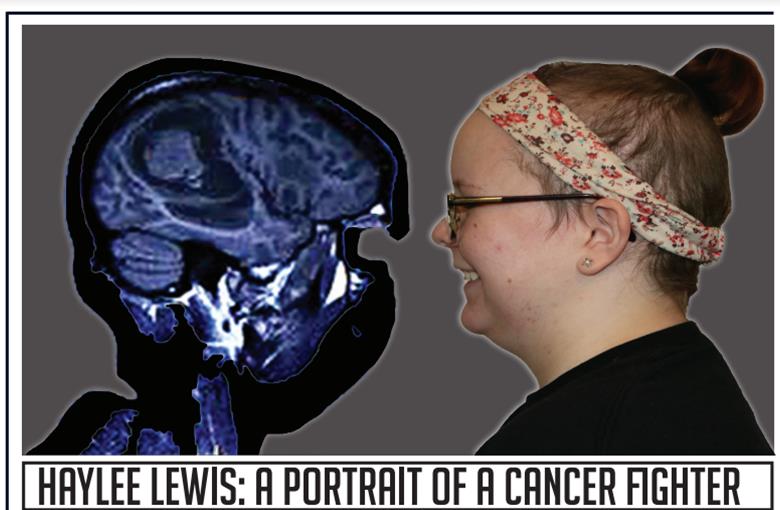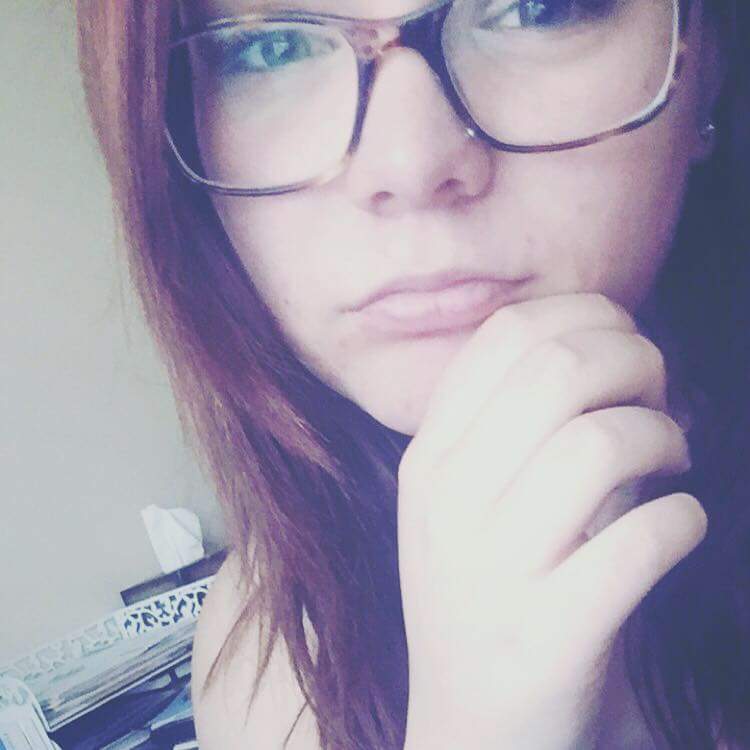Haylee Lewis: portrait of a cancer fighter
NOTE: This is a reprint of the article on Haylee Lewis, 9/10/1999-4/13/2017, from the February edition of the Northern Light.

Haylee’s Story:
She found herself in a bustling hallway trying to get to her next class as friends followed her stride – everything seemed normal for bright high school student Haylee Lewis. When she found herself in class, she was attentive and learning until her head started to spiral into pain. Just another normal recurring headache…until one inflicted so much pain that she was admitted into the hospital. From there, the truth of her health and wellness could only be told by CAT scans and MRIs. However, unlike most patients, Lewis was not intimidated by the enormous machines and chaotic hospital scene; this is because she was diagnosed with leukemia at just 9 years old. While her peers were in elementary school playing, Haylee was at the hospital fighting. This fighter mentality followed Lewis through 2 years of intense chemotherapy and complete hair loss before she went into remission. Just last year, her doctor finally said a word that made Lewis’ hope for the future flourish: cured.
Just one month later, she was in the emergency room due to the searing pain in her head. The new tests suggested that years of accumulating radiation has led to the source of her headaches: glioblastoma, a highly malignant, aggressive, invasive brain cancer that they had no idea she had because it does not present in any bloodwork. What shocked her family and herself was that there were three tumors, one primary and two secondary, that had caused bleeding in her brain. The primary tumor was very large – so large that it managed to move the midline of her brain. After Dawn Lewis (Haylee’s mother) saw the results of the tests, she was shocked. “They weren’t telling us that it was cancer, but with her history, we knew that it was,” said Dawn. “When they showed us the MRI, I couldn’t believe the tumor was that big. It looked huge,” she added. “I couldn’t believe that she had a tumor that big and all she had was a bad headache.” The results meant that Haylee would once again go through the lengthy process of treating and fighting cancer, a routine that she had looked forward to escaping.
Haylee’s condition was so serious that she had her MRI on July 30th and was in surgery on August 2nd with the goal of removing as much of the tumors as possible. The deep tumors could not be removed, but surgeons were able to resect about 60% of the mass of the large tumor. “They told [us] that she had 6 months and told us to take her home,” Dawn said. Not happy with that answer, Haylee’s parents made her an appointment for a second opinion at U of M’s Mott Children’s Hospital, where they gave her hope and prescribed a treatment plan that involved 6 weeks of intense radiation followed by oral chemotherapy. “The radiation was successful on the two smaller tumors. They aren’t even showing up right now on the MRI,” Dawn said. Because there is no cure for glioblastoma, the goal of the oral chemo is to shrink the size of the existing tumor and prevent new tumors from growing. “U of M helped us have more hope,” said Dawn. “The doctors there don’t give you a life expectancy or a timeline. They focus on one treatment option at a time and do their best to improve the here and now.” According to the American Brain Tumor Association, patients with Haylee’s cancer have a six-year median survival rate of 25%, which can be scary. “Having cancer again is different because I am more aware of everything now,” Haylee said. “It’s more scary because there is no cure for my cancer. Sometimes I am afraid to die.” Despite the hospital stays, that’s actually not the worst part of her fight. “I joke that the hospital is my second home,” she said. “One of the hardest things is that I want to be like a normal teenager, but I can’t,” said Haylee.
Family Impact:
Cancer is obviously not a fight that Haylee has to battle alone; the love from Dawn, Shawn Lewis (her father), and Zach Lewis (her little brother) gives her strength and courage.“It’s hard not being at school everyday,” Haylee said. “My friends and family are what keeps me going. Even when I can’t be at school, my friends text me a lot and if I feel good enough they come over and see me or I go over and see them.” Because of Haylee’s battle with cancer, her family needed to adjust their lifestyles to ensure Haylee’s progress toward being cancer free and to be able to pay for the costs. Dawn said that the biggest transition for her was learning what it was like to be a full time caretaker. “In the ER, I would meet caretakers who looked after an elderly person and had to lift them and help them with basically everything. I had never experienced that with a grown-sized person. I really respect anyone who is a caretaker because it is a big responsibility.” Furthermore, this experience brought back the financial reality of going through cancer treatments for the Lewis family. “Having to miss work is a big factor,” said Shawn, who works at Kaiser Aluminum. “When you have a normal teenager who isn’t feeling well and can’t go to school, you can leave them at home to rest by themselves. We can’t do that because something could happen.” The family accommodates for Haylee’s illness and will go to great lengths to ensure her wellness, However, this cancer treatment comes with many different price tags. Dawn worked as a full-time ER technician before having to go to on-call status to accommodate all of the appointments and Haylee’s care needs. Missing work and having to travel across the state for appointments have had a big financial impact on the family. Additionally, while the medical bills have largely been covered by insurance, other important expenses have not. For example, Haylee’s wig and her emotional support counseling are expensive and not covered by insurance.
Kept mostly isolated from the grown up financial realities of Haylee’s condition is Zach, the loving brother that observes Haylee through all her struggles and successes with the cancer treatment. When asked about how he felt about Haylee’s situation, he said, “The same as having a normal sister, just a really sleepy one.” Zack also said, “I worry a lot, but I try not to worry too much.”
Childhood Cancer Research & Funding:
One of Haylee’s biggest frustrations is the lack of funding and research for childhood cancers. Only about 4% of federal and American Cancer Society funding goes specifically toward childhood cancer research. As a result, research is limited and few new treatments for children are available. Most of the standard practices now are to offer adult treatments at lower doses. In fact, according to the FDA, only 2 new cancer drugs have been approved for children in the last 20 years. “About 20 years ago, doctors were able to drastically increase the cancer survival rate from 45% to 80% by starting to use spinal fluid chemo injections. There was so much progress at that time that it seems like it’s not as urgent to make the same kinds of discoveries now,” Dawn said. In Haylee’s case, the five-year survival rate for glioblastoma has not changed significantly over time due to lack of research. The reasons for the lack of momentum for child cancer research is because it is not profitable for the companies who produce them. Because of this, childhood cancer advocates worked to get the Creating Hope Act passed in 2012, which offers companies vouchers to expedite the development and approval of these drugs. “Chemo drugs are the only medicine that hospitals can significantly mark up,” said Shawn. “They can purchase the drug for $2,000, charge the insurance company $10,000, and pocket the rest.” This creates a situation where providers, not drug companies, profit off the drug and also where families who are already fighting cancer have to also fight insurance companies to pay for the treatments.
How to Help
Outlets to help include local and nationwide organizations, and participating in either or both will put us one step closer to helping Haylee and others that suffer from cancer. “We do Relay for Life because we know other cancer families that we are able to go and support, but it’s hard because we know where their money goes,” Dawn said. National groups are working on pediatric cancer treatments that would be good to donate to are the Leukemia and Lymphoma Society, Cure Search, and the Children’s Oncology Group. Locally, Cancer Families United and DC Strong (operated by the family of Haylee’s cancer friend, Dustin) are helping local families cope with the experience of childhood cancer. When asking Haylee about the thing that she needed to overcome this illness, she responded with, “Hope. You can’t lose your hope.” In fact, the fundraisers to support Haylee’s family have been called Haylee’s Hope because being hopeful has gotten Haylee and her family through this journey. See https://www.facebook.com/hayleeshope/ for more information.
Although Haylee carries her illness with her, she refuses to let it be a definer by making her own strides to create the normal life she’s always wanted. Haylee even works at Auntie Anne’s in the mall, and she says it’s because, “It gets me out of the house. I’m home a lot, and I watch a lot of TV and rest. I like to be out if I can.” Haylee also has aspirations to become a veterinarian due her love of animals. This goes to show how Haylee will not put her life on pause for an illness and that she isn’t so different from the students at Portage Northern High School after all. Haylee is an inspiring and strong student who is a portrait of a cancer fighter, and with her family’s support, community’s involvement, and her willpower, she is determined to be a normal teenager.




